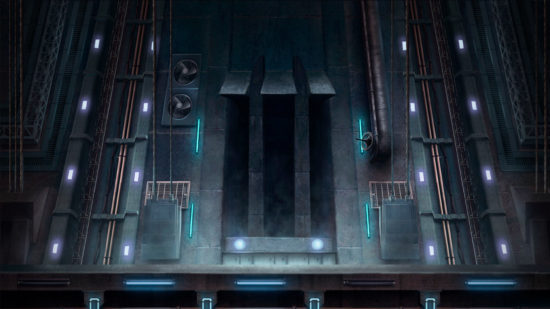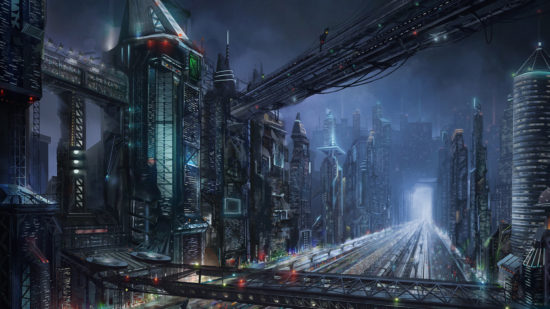Content
Major video game releases invariably draw a sea of interest, often spurring a barrage of articles and discussions that fill our news feeds. Among these, you’ll find particular attention given to the game art style — a vital aspect often dictating its overall appeal. With the proliferation of exciting game art styles, every title announced fosters anticipation of unmatched graphics, pioneering design, and unprecedented realism.
In the midst of this whirlwind, one might be led to believe that 2D video game art is extinct, overshadowed by the apparent supremacy of 3D game art. However, this isn’t entirely accurate. The industry’s art styles, whether 2D or 3D, have unique charms and significant roles in game design. It’s fascinating to observe the diverse game art styles, each contributing to the richness of the gaming landscape.
Considering the prevalent belief, it might astound you to know that 2D art services are not only surviving but also flourishing in the gaming industry. Before you let confusion take over or dismiss the notion, give us a chance to elaborate. We’re going to delve into the various contemporary 2D game art styles and provide some illumination about their standing in the present times.
What is 2D Art?
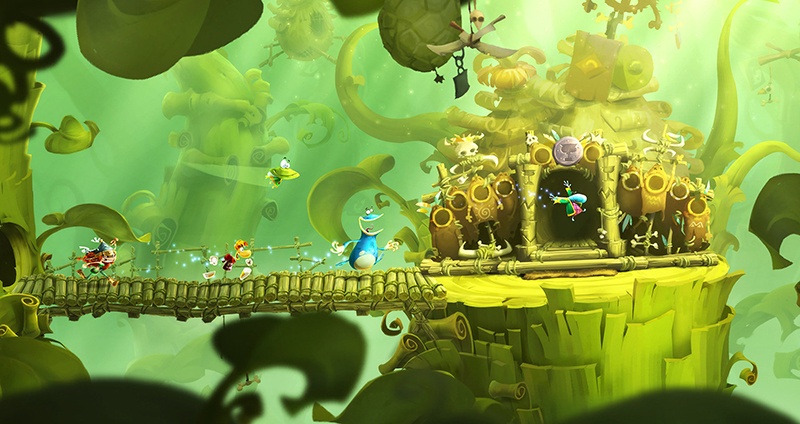
When we dive into the captivating universe of video games, there’s a layered dialogue to be had about game art styles. It is in these discussions that we begin to unravel the multifaceted nature of gaming, recognizing that it goes beyond merely the mechanics of the games themselves.
In the domain of video game art, it is the fusion of art and style that injects vitality into each title. This blend, this harmonious marriage of creative elements, breathes life into our beloved digital worlds, leading to the creation of truly immersive environments that gamers relish exploring. Art is not a peripheral element in the design of video games; instead, it stands as the very heart of their identity and appeal.
Consider the simplicity yet richness of 2D game art styles. The term “2D” refers to two-dimensional, encapsulating designs comprising flat shapes and objects. The dimensions at play here are width and height, contrasted with the depth or length found in 3D game art styles. For a more precise understanding, picture a triangle drawn on a piece of paper. It’s a basic 2D shape, boasting three sides and no depth.
Now, if you were to infuse that triangle with additional sides and depth, it would transition into a pyramid, a 3D object. While 2D designs might appear flat on the surface, their capacity for creative expression is boundless. Through the use of color, line saturation, style, and unbridled creativity, 2D game art can encapsulate an array of unique characteristics.
Whether it’s the nostalgia-imbued charm of pixel art in retro games or the stark, impactful design of noir-inspired titles, 2D video game art styles continue to showcase a wide array of artistic expressions. This diversity within game art styles demonstrates the immense creativity that fuels the video game industry and the undying appeal of the 2D design that, even in an age of 3D dominance, continues to captivate gamers worldwide.
Delving into a historical overview
The tradition of 2D art stretches back to the dawn of human creativity, echoing from the earliest cave drawings found in remote corners of the world. This artistic medium, profoundly versatile and accessible, has found its expression in countless forms throughout human history, including board games and other entertainment avenues that spanned centuries. However, it was the relatively recent advent of computers and video games that unlocked a hitherto unexplored potential in 2D art, enabling it to flourish and evolve in exciting new directions.
With the birth of 2D game art styles in the digital age, art assets truly sprang to life, transforming the gaming experience through dynamic mechanics, riveting cut scenes, and vivid animation sequences. This creative medium fostered the growth and diversification of game art styles, eventually leading to the emergence of the immersive 3D realm.
The emergence and supremacy of 3D
Video games, as a form of mass entertainment, rose to popularity during the 1970s. Merely a decade later, the first successful 3D titles began to grace eager gamers’ screens worldwide. These games quickly rose to the top of bestseller lists, their immersive, lifelike worlds captivating audiences and sparking predictions about the impending extinction of their 2D counterparts.
Yet, against the backdrop of these forecasts, an unexpected trend began to emerge. While 3D titles continued to grow in popularity, refining and advancing with each new release, 2D game art styles did not fade into obsolescence. Instead, 2D games persevered, albeit at a slower pace than the meteoric rise of 3D, and continued to engage and thrill players across the globe.
The enduring appeal of 2D games
Over the past four decades, titles showcasing 2D art and animation have not only survived amidst the dominance of 3D but have managed to maintain the favor of millions of gamers. Some of these 2D titles, like Hollow Knight, Rayman, Limbo, and Undertale, have transcended the confines of niche popularity to achieve widespread acclaim, testifying to the enduring appeal of 2D game art styles.
These successes underscore the fact that the art of video games is not merely about technological prowess but rather the creative vision that weaves together art and style into a compelling design. This truth is manifest in 2D games, which continue to create evocative, captivating worlds through their unique blend of simplicity and creative depth.
2D Game Art Styles
In the early days of video game creation, the simplicity of the available graphics capabilities confined game art styles to straightforward shapes and sparse details. These were the limitations defined by the then software and hardware technologies, starkly contrasting the current 2D game art styles we witness today.
Advancements in technology not only expanded the possibilities for greater detail and creativity in game design but also opened the door for a variety of 2D game styles to flourish. As these innovative tools became available, designers pushed the boundaries of game art style, resulting in the rich diversity of styles present in 2D games today.
2D pixel art
![]()
One such style that continues to charm gamers is 2D Pixel Art, a popular trend in video game art. At the most basic level, a pixel represents a tiny square or basic shape forming a minuscule component of a character, object, or setting in a pixel art drawing or digital image. Designers create detailed and engaging visual elements by combining hundreds or even thousands of these pixels.
Many nostalgically associate pixel art animation with the era of early video games and arcades. While Pokemon pixel art may not be as prevalent as it was in its heyday, it still elicits fond memories and warm nostalgia among many players. However, the appeal of 2D pixel game art style is not merely historical — contemporary game designers frequently incorporate this art style into their work, a testament to its timeless allure. The enduring popularity of this design aesthetic reflects the power of art and style to enrich the video game experience.
Examples of modern 2D Pixel Art games:
- Fez
- To the Moon
- Undertale
- Owlboy
Vector art
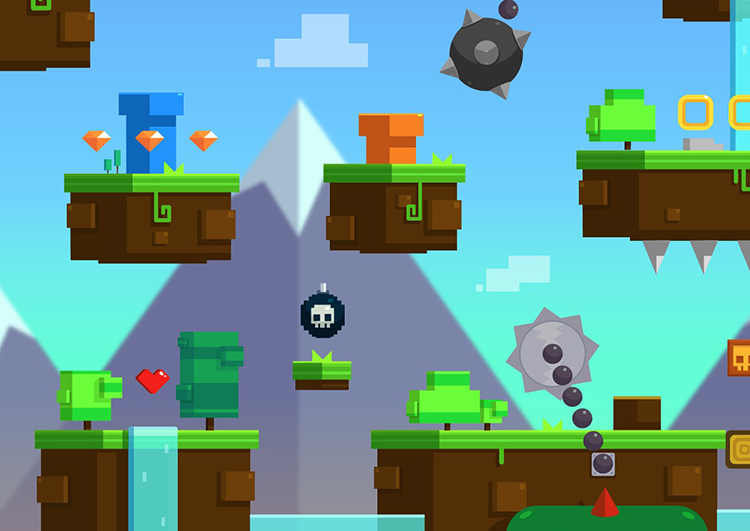
Vector art is another significant contributor to the diversity of game art styles, albeit more precisely classified as an “art variety.” Developed through specialized digital software programs, vector imagery diverges from the pixel style that breaks images into discrete units. Instead, this style constructs images using mathematical algorithms, capturing data in the forms of polygons, dots, and lines, along with color data.
Unlike pixel-based designs, vector art boasts a smaller image file size while ensuring superior quality, whether enlarging or zooming out on images. The unique trait of maintaining high resolution regardless of manipulation speaks volumes about its versatility in video game art and design. This has prompted game designers to embrace vector art in crafting the artistic elements of 2D game styles.
Vector art styles are manifold, each with unique flair, yet they all share the common attribute of delivering high-quality, high-resolution imagery. This characteristic, coupled with the style’s inherent adaptability, makes vector art a preferred choice among game artists and designers, reinforcing its valuable role in the sphere of video game art style.
Vector game examples:
- Steamworlds Heist
- Red Alarm
- The Banner Saga
- Ghost Trick
Cutout art

Cutout art holds a distinct place in the panorama of game art styles, predominantly utilized in animation. Echoing its moniker, this style mimics pictures skilfully carved from paper and transposed onto a new platform or medium. A character’s digital asset, for instance, can either be drawn from tangible paper cutout art or designed directly on a computer before being introduced into the video game’s universe.
Despite the static nature of the cutout image, its position can be dynamically altered to emulate action and movement. Furthermore, it can be instantly substituted with another cutout to simulate a change in state, adding an intriguing layer of dynamism and interactivity to the otherwise still art.
Cutout art blurs the boundary between traditional arts and digital design, contributing a unique aesthetic to 2D game styles. It plays an indispensable role in shaping the game art landscape, demonstrating the multifaceted nature of video game art and the endless possibilities of style and design within games.
Cutout game examples:
- Paper Mario
- Sonic 4
- Sega Heroes
- Don’t Starve
Cel shading art
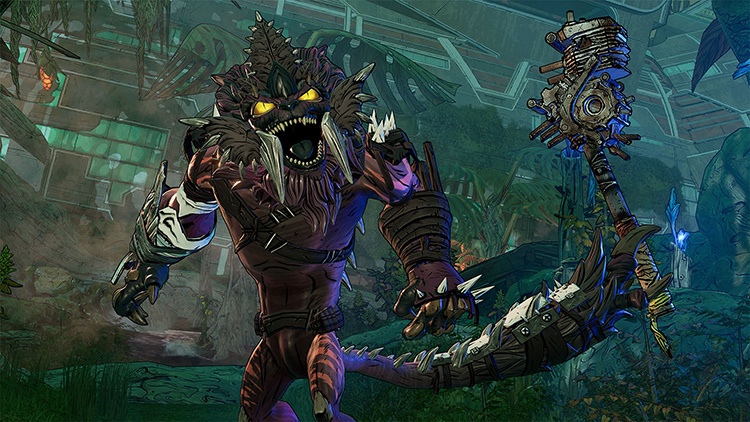
Cel shading has emerged as an innovative style in video game art, wielding considerable influence in the game development community with numerous well-known applications. This art style is unique in its endeavor to give 3D models and objects a 2D, flat, and paper-like appearance, creating a fascinating blend of dimensions in game design.
Imagine observing a coffee mug morphed into a 3D model. Through the technique of cel shading, you can seize the perspective of this 3D model from a designated angle and transpose it onto paper, thereby nullifying depth while retaining only a facet of the mug’s visibility. Consequently, objects and characters maintain a high level of detail but sacrifice their volume, bestowing upon games a captivating visual dynamic that can reshape the customary game art styles in the sphere of video games.
For instance, the application of Unity’s cel-shading features played an instrumental role in molding the distinctive look of the successful game, Borderlands. It’s a testament to how cel shading can enhance the spectrum of 2D game art styles and escalate the artistry and design of video games.
By innovating within the confines of traditional game art styles, cel shading can introduce a fresh perspective to the visual representation of video games. This technique redefines how objects and characters are perceived in a game, subtly shifting the player’s experience and interaction with the game environment. Borderlands, a shining example of such innovation, demonstrates the potential of cel shading to break the mold of traditional game art styles and bring a unique visual identity to a game.
Therefore, cel shading’s transformative impact on game art styles cannot be understated, bringing a fresh and distinctive aesthetic to the design of video games and demonstrating the continued evolution of artistic expression in games.
Examples of cel shaded games:
- Ultimate Spider Man
- Jet Set Radio Future
- Mega Man Legends
- Pokémon X & Y
- X-Men Legends
Monochromatic art
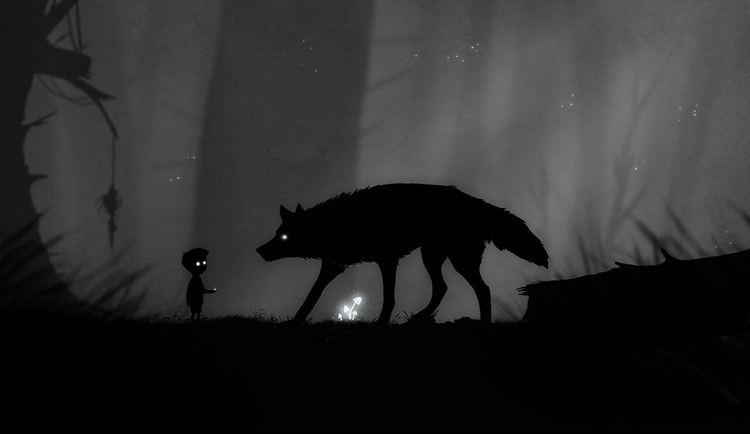
Monochromatic art, though not universally defined, is typically characterized in artwork and design by its restrictive use of color. Predominantly, these art styles employ one or two colors at most, supplemented by an expansive spectrum of shades and tints of the selected color(s) to differentiate objects, settings, and distinct elements within an image.
Within the context of video game art, the monochromatic art style plays a significant role in molding the visual language of various games. Often, black becomes the most common choice for such art styles, establishing a striking contrast against other elements differentiated through white or shades of gray.
This design approach serves to establish a unique aesthetic for 2D game styles, thus enhancing the allure of video games, showcasing the endless possibilities within game art, and pushing the boundaries of style and design within this interactive medium.
Monochromatic game examples:
- Limbo
- Badlands
- Inside
- Minit
- One Upon Light
Flat art

Flat design is a fascinating approach in video game art, marked by its commitment to simplicity over realism. This game art style represents objects, characters, and environments in two dimensions, eschewing depth and volume. Unlike the deliberate nod to physics seen in cel-shaded games, flat design in video games reveals artistic freedom and creativity.
Artists venturing into this art style find the liberty to experiment and innovate, giving each game its own unique identity. While no defining characteristic is common to all flat designs, these game art styles often incorporate elements borrowed from other art trends, further diversifying the look and feel of individual games. It’s an innovative twist in 2D game styles, showing off video games’ boundless possibilities of art, style, and design.
Flat game examples:
- Gravity Defied
- Stick War
- Flat Kingdom
- Nidhogg
Doodle art
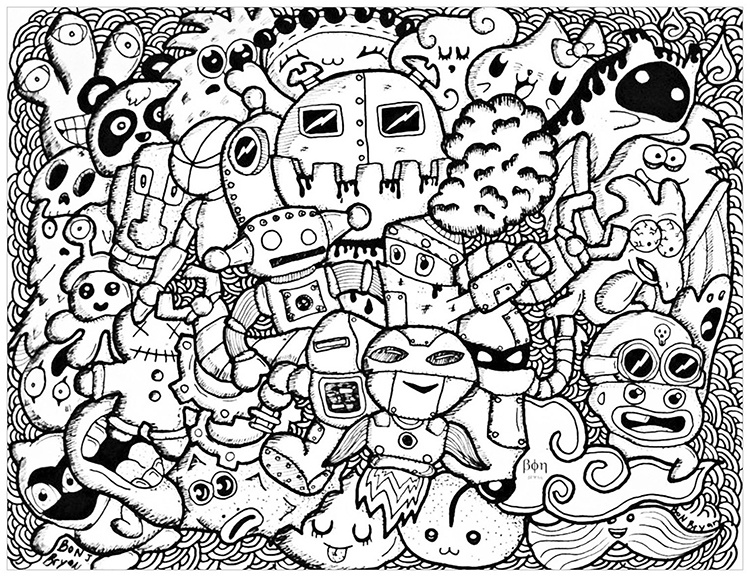
Doodle art stands out with its unique foundation among the myriad game art styles. Defined more by the process and the content rather than a particular aesthetic, doodle art thrives on abstraction and spontaneity.
Doodling, essentially drawing while the mind is preoccupied elsewhere, can lead to the birth of abstract, extraordinary, and alluring compositions. Frequently, these doodles culminate in a jumbled collage of unrelated characters and objects, each staking their claim in the overall piece. The doodle game art style’s absence of rigid structure and design confers a captivating, whimsical quality that can considerably amplify the artistic depth of 2D video game styles.
In the world of video games, doodles can serve as critical building blocks for digital assets in game art. Initially created by hand, these doodles are subsequently imported and seamlessly integrated into the game’s universe, infusing a personal and distinct touch to the video game. This fascinating convergence of art, style, and game design carves out a unique visual language for games, making the doodle game art style a dynamic and engaging choice.
The doodle game art style’s inherent unpredictability and charm can inject a fresh perspective into the visual representation of games, underlining its potential to redefine traditional video game art. By embracing such non-traditional game art styles, video game developers can create more diverse and inclusive gaming experiences, demonstrating the multifaceted potential of art in games.
Doodle game examples:
- Doodle Jump
- ToonTown
- Krusty Towers
- Google Doodles
By no means is this an exhaustive list of styles used in 2D, but it includes some of the most prominent styles used today, as well as promising styles that may grow to fame in the future.
How to Create 2D Game Art
While the allure of hand-drawn designs, echoing the notebook drawing game art style, can frequently be observed in 2D game concept art or board games, their application in video games tends to be less widespread. In the expansive vista of video game art, digital tools hold sway. Therefore, budding game artists should brace themselves for spending substantial time refining their skills on a computer or tablet.
Creating 2D video game art transcends using basic tools like Paint for Windows. Professional game art design necessitates advanced software specifically tailored to fulfill the varied requirements of the game’s art style. The selection of software may vary depending on the design task at hand — whether it involves creating a character model, designing a backdrop, crafting an interface, or producing bitmaps, sprites, and animation elements.
Given the rapid technological advancements, the tools available for creating distinctive game art styles for video games are continually evolving. This ever-changing landscape offers boundless opportunities for artists to bring their unique visions to life in video games. This, in turn, enriches the diversity and breadth of visual representation in games, making each video game a unique artistic endeavor.
The diverse array of game art styles available today is a testament to the sheer creative capacity of these digital tools. From sketching preliminary designs to polishing the final video game art, these tools play a pivotal role in shaping the aesthetic and narrative experiences of the game, making them an integral part of the art, style, and design journey in video games.
Top 2D Game Art Software:
Many of these programs have a difficult learning curve, and can only be used confidently and efficiently by experienced 2D artists and designers, though it is certainly possible to become proficient in this field through reading and practice.
Conclusions and Outlook
There’s a prevalent misconception about the creation of video games, suggesting that there’s exclusivity between 2D and 3D technologies. In reality, even video games with a primary focus on 3D graphics often incorporate numerous 2D assets and elements. These appear ubiquitously in menus, backgrounds, user interface options, and beyond, showcasing an interesting blend of game art styles. Consequently, 3D designers frequently engage with 2D game art, indicating intersectionality despite a predominant focus on 3D.
Moreover, this intersectionality of 2D and 3D art elements adds depth and diversity to the game’s aesthetics. It helps create a more dynamic visual experience for players, highlighting the importance of multiple game art styles in enhancing the overall appeal of video games. Whether it’s a highly intricate 3D model or a minimalist 2D sketch, each element plays a crucial role in defining the game’s unique visual identity.
Video game creation is multifaceted, with a blend of 2D and 3D game art styles often employed. This underlines the fact that both forms of art are essential to the successful development and reception of video games, and underscores the importance of understanding and appreciating the intricate interplay between different game art styles in the game development process.
This ubiquity of 2D design has fortified its position in the gaming industry, manifesting a robust 2D game art market that thrives to this day. The appeal of 2D releases among players sustains this strength, a sentiment reflected in the recent success of 2D hits like Celeste, Super Ghouls, Ghosts, Undertale, Cuphead, and Worms.
Looking to the future, we foresee a continued demand for diverse game art styles and technologies. Game creators will likely strike a balance, harnessing the individual merits of both 2D and 3D art styles. While 3D art may command a prominent role in the market, shaping its evolution, 2D game art undeniably remains a fundamental pillar in the design and success of video games. This convergence of art styles ensures a rich tapestry of visual experiences in video games, appealing to a broad spectrum of player preferences.
2D game art design services
Creating breathtaking video game art and captivating designs is an endeavor that requires a significant investment of time and effort. This doesn’t merely involve the hours spent on a specific game art piece but extends to the years it takes to cultivate and hone one’s artistic prowess in this field. Equally important are the chosen game art styles, as they heavily contribute to the overall visual identity of the video games being developed.
This demand for proficiency, often coupled with a need for more skilled artists in various game art styles, leads many gaming studios to seek expertise beyond their in-house teams. This is particularly true for video games that rely heavily on a distinctive and captivating visual presentation.
Thus, the game development landscape has seen the rising popularity of 2D game art outsourcing services. These services offer a platform of numerous companies teeming with talented artists and designers, each skilled in their game art styles, ready to contribute their innovative design ideas to your video game project.
In an industry where art and design hold such paramount importance, these outsourcing services play a crucial role in facilitating the creation of visually stunning games that captivate players worldwide. They offer a broad spectrum of game art styles, enriching video games’ visual diversity and appeal. Such an approach enhances players’ immersive experiences and helps video games stand out in the highly competitive gaming market.
Ultimately, the art style of a video game is a crucial component that defines its identity and marketability. Hence, when developing games, the selection of game art styles and the decision to outsource art creation are strategic choices that can significantly impact the success of the games.
Choosing the right team to assist with your project is important, and we recommend that you pay attention to such factors as experience, certification, and portfolio when making your choice. 3D-Ace is one of the longest-running art studios in Eastern Europe, boasting over 26 years of gorgeous artwork and designs. Our specialists are qualified in a range of services, from 2D art creation to VFX and animation, and you can see some of the marvelous work they have done here.

